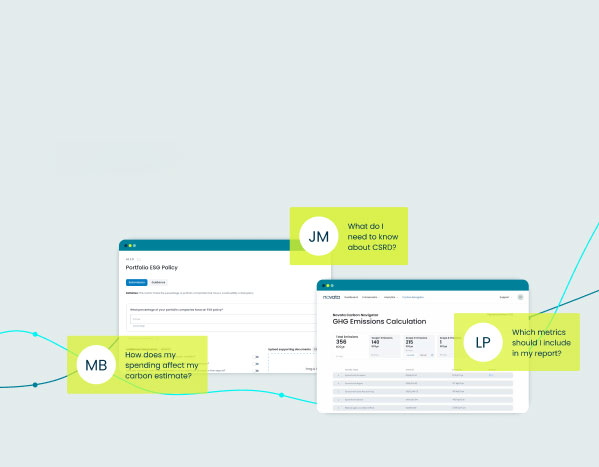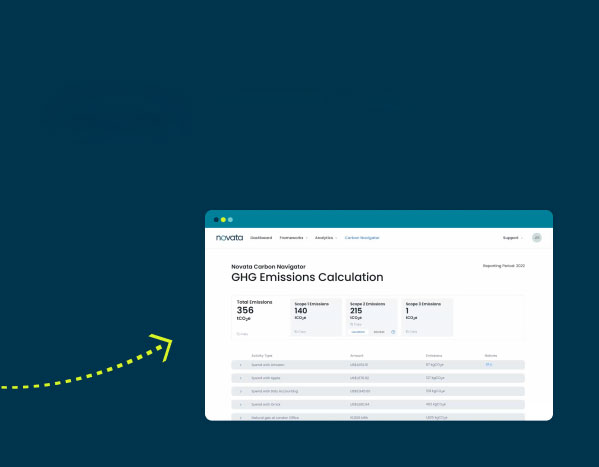2023 marked the midpoint for achieving the 2030 UN Sustainable Development Goals (SDGs). Introduced in 2015, the SDGs ambitiously set out to eliminate all forms of poverty, confront inequalities, and bring climate change to a halt. However, the latest global-level data presented in this year’s SDG Progress Report reveals that current progress presents a real risk for accomplishing the goals by the 2030 target date. Of the 140 targets with available data, half of them deviate from the desired trajectory, and more than 30 percent of these targets are failing to progress at all or have backslid and now exist below the 2015 baseline.
Getting the global agenda back on track will require action across sectors, including the private markets. In the corporate sector, the SDGs have emerged in recent years as one avenue for companies looking to grow and advance into the sustainable business sphere. At Novata, we often receive questions from clients about how they should report on the goals and how we can support that effort. To effectively incorporate the SDGs into a company’s sustainability strategy, it is critical to understand the purpose of the goals, who they were designed for, and how they relate to prominent ESG standards, frameworks, and regulations. Only then can a company begin to meaningfully align to the most material goals set out under the 2030 UN SDGs.
What Are the Sustainable Development Goals?
The Sustainable Development Goals are a collection of 17 global goals set by the United Nations in 2015 as a call to action to preserve the planet and improve lives everywhere by 2030. The 17 SDGs and 169 associated targets cover themes intent on eradicating poverty and inequality and improving health, education, and economic growth while slowing the causes and effects of climate change and preserving the Earth’s land and sea.
Who Were the SDGs Designed For?
The UN Sustainable Development Goals materialized after three years of development by an intergovernmental working group of representatives from 70 countries, open to public consultation and inclusive of civil society engagement. The SDGs apply to all countries at the regional, national, and global levels and consider the varying degrees of resource availability and levels of development.
The SDGs are not legally binding, a frequent challenge and criticism of the goals. However, countries are expected to strategize, take control of, and establish a framework for advancing the global achievement of the goals.
While designed for governments, the 2030 Agenda cannot be partially, let alone fully, achieved without multi-stakeholder engagement. The 2023 midpoint emphasizes the urgent need for ramped-up participation from member states, citizens, civil society, the private sector, financial institutions, and others to accelerate action towards a common agenda.
Why Are the SDGs Important?
Data shows the real-world implications of the current trajectory of the global agenda. For instance, there have not been this many hungry people in the world since before 2005; by 2030, 575 million people will still be living in extreme poverty; and almost three centuries will go by before we can close the gender gap and remove discriminatory laws.
Private market engagement in the SDGs can contribute to a recovered path for achieving the 2030 Agenda and creating a real impact on the people and planet.
Using ESG Standards and Frameworks to Report on SDG Performance
Within the ESG space, the ever-increasing availability of frameworks and standards provide a foundation for applicable, consistent, and high-quality data. ESG regulation is also making comprehensive reporting mandatory for companies. The SDGs do not neatly fall into these categories, spurring the potential for ineffective alignment. Unlike the GRI Standards, which were written for and used by companies looking to report on their sustainability impacts, the SDGs were created with member states in mind.
Companies, therefore, cannot approach the SDGs as though they were the intended audience. Instead, to effectively align with them, companies must use the SDGs in conjunction with prominent ESG standards and frameworks to assess materiality, plan and set targets, act, and report thoroughly.
Four Steps to Meaningfully Align to the SDGs
A 2020 GRI study of 206 companies revealed that 80% of businesses assessed are committed to aligning with the Goals of the 2030 Agenda. However, the study found inconsistencies in what that alignment entailed. A majority included at least a statement of support for the SDGs and articulated which Goals were material to their business. A smaller proportion set measurable commitments, and even fewer included evidence of assessed impact.
It can be easy for companies to declare themselves loosely aligned with one or more SDGs; however, companies need more tangible plans to move the 2030 SDG Agenda forward at a sufficient pace.
Organizations should consider the following practical steps:
1. Assess materiality:
Companies should determine how their external contributions and internal operations relate to the root of each SDG. Completing a double materiality assessment can help to identify the Goals most relevant to the organization, its activities, products, and suppliers.
2. Plan and target set:
Within the Goals identified in Step 1, outline the operative targets the organization can help advance. Linking to a Goal’s specific objectives and targets clarifies and ensures that businesses act with purpose and intent behind the Goals they plan on aligning with. Learn more about Novata’s approach to SDG planning and target setting.
3. Measure and assess:
The SDG targets are not all measurable and assessable in the format they are written in, thus requiring organizations to use relevant metrics laid out in global ESG standards and frameworks. The GRI partners with the UN Global Compact to facilitate corporate reporting on the SDGs. The 2022 Analysis of the Goals and Targets is a useful document listing in detail the existing and established disclosures that companies may consider for measuring and assessing, from a business lens, their impact and contribution to selected targets.
4. Report thoroughly:
There are three pieces critical to include in any report:
- The positive actions carried out by the organization to demonstrate its support and advancement of the material Goal(s) and relevant targets.
- The company’s actions that negatively impact the Goal(s) and targets. Including this information answers stakeholder calls for increased transparency on how businesses identify, stop, and ultimately reverse their negative impacts on the SDGs. This layer of reporting strengthens trust between the organization and its stakeholders and ensures accountability for the business itself.
- Provide evidence of target progress in numerical and quantitative data, which allows for greater comparability, analytics, and benchmarking.
Integrating the Sustainable Development Goals into ESG Reporting
Businesses are key players in driving progress toward achieving the 2030 Sustainable Development Goals. Collecting relevant data can help companies track and understand their impact against these goals. Novata works with investors and portfolio companies to determine how best to align with the SDGs and collect the relevant data needed for reporting. Learn more about how Novata can help you identify the frameworks and metrics that best fit your needs.






